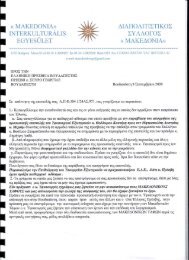Görög Örökség Ελληνική Κληρονομιά - H-ellin.com
Görög Örökség Ελληνική Κληρονομιά - H-ellin.com
Görög Örökség Ελληνική Κληρονομιά - H-ellin.com
You also want an ePaper? Increase the reach of your titles
YUMPU automatically turns print PDFs into web optimized ePapers that Google loves.
BÉLLAK GÁBOR<br />
GREEK PAINTERS IN BUDA AND PEST<br />
DURING THE 19 TH CENTURY<br />
The Hungarian art is overwhelmed by many artists of origin and language other than the<br />
Hungarian. It is open to question, how much the value of Art is affected if we know the origin of the<br />
artist before s/he is incorporated into the Hungarian civilization. The artist's origin is a social,<br />
scientific and historic question, however, in the History of Art, and it is the works of the artist that<br />
determine his/her origin and identity. In the 19' century in Hungary, a lot of Greek artists can be<br />
found, few however are those who convey strictly the greek mentality, since they are influenced by<br />
the Hungarian cultural element. Besides, during that era, in Europe, the artists are living in a multilingual<br />
and multicultural environment. In Hungary only the Greek religious art has been transferred<br />
and along with the Hungarian mentality make a notable appearance.<br />
The Greek revolution as a source of inspiration for the artists of central Europe in the 19'<br />
century.<br />
Every artist has his/her own personal life which is revealed through his/her technique. It is<br />
important to stress out that his/her expression is influenced by the family, the faith, the habits the<br />
success and also the level of adaption to the environment where the artists live.<br />
The most significant element of the everyday politics during that period of time, is Europe's<br />
philhellenism which starts since the excavations held by Johann Joachim Wickeimann (1717-1768),<br />
who in the 19 th century inspired the spiritual ideology of Sciller, Hölderlin, Goethe, Stefan George<br />
and Arnold Böcklin.<br />
In 1820 everybody is impressed and inspired by the Greek revolution and especially the<br />
painters who select their Greek topics with much love, displaying thus, their support towards the<br />
revolutionaries. Some samples of the modern-Greek adoration are the exceptional works of<br />
Delacroix, Leo von Klenze, Karl Friedrich éáé Carl Rotman.<br />
The feeling of sympathy towards the Greeks is obvious in Hungary too. For instance, in<br />
the first exhibition of Műegylet in the Centre of Culture, is displayed the painting of Eugen<br />
Hummel: " Portrait of a Greek woman". Moreover, the baron Karl Wilhelm Heidegger von Heidegg<br />
who is in Greece as a military figure, in his exhibition in 1842 displays the Greek landscape. The<br />
exhibits of Johann Ender andWeber Hernick are also based on Greek topics.<br />
It is worth mentioning that Marastoni Jakovos the most important painter in Hungary in the<br />
19th century and founder of the Academy of Artists in Pest painted in 1845 the painting with the<br />
topic of 'The Greek Woman'. This piece of work initiated the birth of the autonomous Hungarian<br />
Museum of Fine Arts. The Hungarian Beidermeier with Greek Artists: Lakkataris Dimitris<br />
Lakkataris Dimitris (1798-1864)<br />
He was born in Vienna in 1789. He studied in Debrecen and Vienna and his teacher was<br />
Josef Danhaser. In 1835 he was working in Pest, making replicas of other paintings and doing plates<br />
for advertisements. In 1843 for the first time he displays his paintings in the Centre of Culture with<br />
topics of the era: 'Kis Savoyard' (national literature of manners), 'Dorottya', 'Don Quuxette'(historic<br />
literature of manners of 1843), 'The arrival of Attila in Aquileiaba in 455', Ά Kis<br />
mutatványos'(meaning the small tubler, literature of manners), 'Kegyhely'(oil), 'Lord<br />
136




